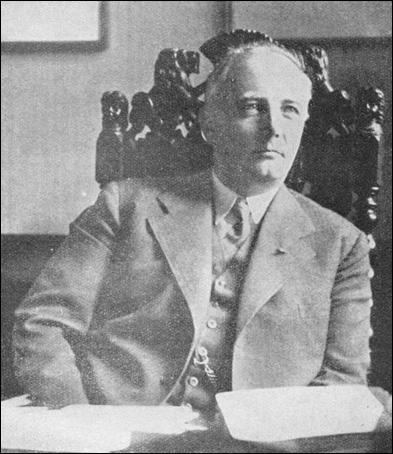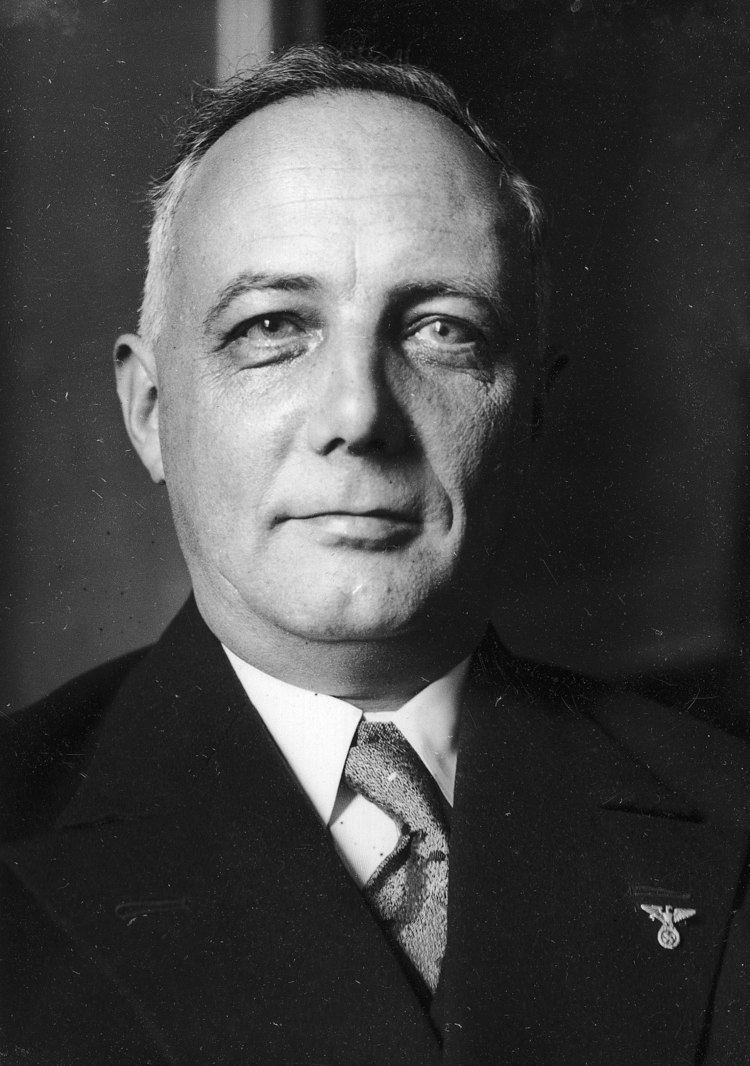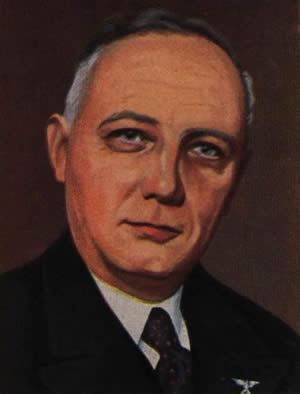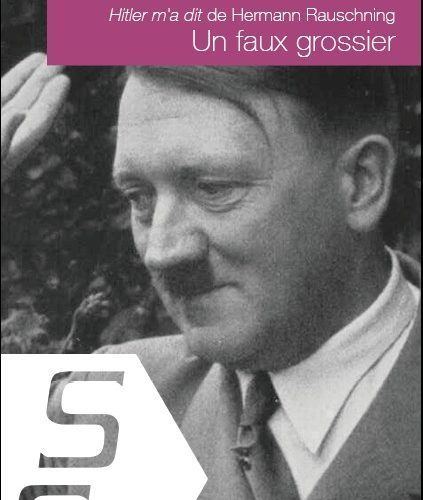Battles and wars World War I | Name Hermann Rauschning | |
 | ||
Education Humboldt University of Berlin Books Hitler speaks, The Voice of Destruction, The Revolution of Nihilism, Men of chaos, Germany's Revolution Of Destru | ||
Service/branch Imperial German Army | ||
Hermann Rauschning (7 August 1887 – February 8, 1982) was a German Conservative Revolutionary who briefly joined the Nazis before breaking with them. In 1934 he renounced Nazi party membership and in 1936 emigrated from Germany (eventually settling in the United States) and began openly denouncing Nazism. Rauschning is chiefly known for his book Gespräche mit Hitler (Conversations with Hitler), US title Voice of Destruction, UK title Hitler Speaks, in which he claimed to have had many meetings and conversations with Hitler.
Contents

Life

Rauschning was born in Thorn (Toruń), at the time part of the German Empire, to a Prussian officer in the province of West Prussia. He attended the Prussian Cadet Corps institute at Potsdam and in 1911 he obtained a Doctorate from Berlin University. He fought in World War I as an Lieutenant and was wounded in action. After the war, he settled in the area around Danzig (now Gdańsk, Poland), where he owned land.

He lived in Posen and was prominent in its Historical Society. In 1930 he published a work under the title Die Entdeutschung Westpreußens und Posens (The de-Germanisation of West Prussia and Posen). According to Rauschning, Germans in these areas were constantly put under pressure to leave Poland.

In 1932 he moved to a new estate in Warnow and became leader of the Danzig Land League. Previously affiliated with the German National People's Party, he then joined the Nazi Party believing that they offered the only way out of Germany's troubles, including the incorporation of Danzig into Germany. He became President of the Danzig Teachers' Association in 1932. After Adolf Hitler came to power in Germany in 1933, the Nazis in Danzig won control of the Free City's government, and Rauschning became the President of the Senate of Danzig on 20 June 1933; that is, head of state of the Free City government. He was an excellent public speaker. In foreign matters Rauschning did not conceal that his personal desire was to turn neighbouring Poland into a vassal of Nazi Germany. As a conservative nationalist Rauschning was not typical of Nazi members, and the Nazis' violent anti-Semitism was alien to him. He was a bitter rival of Albert Forster, the future Gauleiter of Danzig.

On 23 November 1934, he resigned from the Senate and the Party. In the April 1935 Danzig elections, he supported "constitutionalist" candidates against the Nazis, and wrote articles supporting co-operation with the Poles, which angered the Nazis, and Rauschning found himself in personal danger.

He sold his farming interests and fled to Poland in 1936. He moved on to Switzerland in 1937, to France in 1938, and to the United Kingdom in 1939. Rauschning joined German émigrés but his right-wing beliefs did not endear him to left-wing Germans, nor the fact that while a member of the Nazi Party he had been instrumental in the takeover of Danzig. Rauschning represented "one of the most conservative poles of the emigration" and enjoyed celebrity status through his lectures. He sought to play a leading role in the more conservative émigré 'German Freedom Party', run by Carl Spiecher (later of the Centre Party), however he fell out with Spiecher, who thought Rauschning was motivated by self-interest rather than the interest of the party.
Between 1938 and 1942, he wrote a number of works in German addressing the problem of the Nazis which were also published in a number of languages including English. His Gespräche mit Hitler (Conversations with Hitler) was a huge bestseller but its credibility would later be severely criticised, and it now has no standing as an accurate document on Hitler for historians. However, as anti-Nazi propaganda it was taken seriously by the Nazi regime. At the beginning of the war the French dropped leaflets on the Western Front containing excerpts from Rauschnings writings, but with little response.
In 1941 Rauschning moved to the United States, becoming a US citizen in 1942 and purchasing a farm near Portland, Oregon where he died in 1982. He remained politically active after the war and was opposed to the policies of Konrad Adenauer.
Writings
Rauschning's writings that were translated into English deal with National Socialism and the Conservative Revolutionaries' relation to it, and their role/responsibility for Hitler gaining power. By conservative revolution Rauschning meant “the prewar monarchic-Christian revolt against modernity that made a devil’s pact with Hitler during the Weimar period”. Rauschning came “to the bitter conclusion that the Nazi regime represented anything other than the longed-for German revolution”.
In Die Revolution des Nihilismus (The Revolution of Nihilism) he wrote that "the National Socialism that came to power in 1933 was no longer a nationalist but a revolutionary movement" and, as the books title states, a nihilistic revolution, destroying all values and traditions. He believed that the only alternative to Nazism was the restoration of monarchy. His book went through seventeen printings in the United States. The book was directed at conservatives in Nazi Germany whom he hoped to warn of the alleged anti-Christian nature of the Nazi revolution. He would reiterate the anti-Christian nature of Nazism in Gespräche mit Hitler.
Rauschning's ideas of conservative Christian resistance to Hitler met with increasing scepticism, and were of no interest to Winston Churchill and his doctrine of uncompromising total war. He fared little better in the US where "extremists, like Henry Morgenthau argued for the radical dismemberment of the entire German nation".
At the Nuremberg Trials the Soviet Union presented as evidence (USSR-378) two extracts from The Voice of Destruction. Dr Pelckmann, for the defence, asked for Rauschning to be called as a witness on the matter of the party programme relating to the solution of the Jewish question and Hitler's "principle to deceive the Germans about his true intentions" so that the prosecution would have to prove that the SS "knew what Hitler actually wanted" but Rauschning was not called.
Authenticity of Hitler Speaks
The authenticity of the discussions Rauschning claims to have had with Hitler between 1932 and 1934, which form the basis of his book Hitler Speaks, was challenged shortly after Rauschning's death by Swiss researcher Wolfgang Hänel. Hänel investigated the memoir and announced his findings at a conference of the revisionist association Zeitgeschichtliche Forschungsstelle Ingolstadt in 1983.
In his biography of Hitler, Ian Kershaw wrote, "I have on no single occasion cited Hermann Rauschning's Hitler Speaks, a work now regarded to have so little authenticity that it is best to disregard it altogether." Historian Richard Steigmann-Gall, in The Holy Reich: Nazi Conceptions of Christianity, also contends Hitler Speaks an overall fake.
Hänel declared that Gespräche mit Hitler (the German title of Hitler Speaks) was a fraud and that the book has no value "except as a document of Allied war propaganda". He concluded that Rauschning's claim to have met with Hitler "more than a hundred times" was a lie, that the two actually met only four times, and never alone, that words attributed to Hitler were simply invented or plagiarized from many different sources, including the writings of Ernst Jünger and Friedrich Nietzsche, and that an account of Hitler hearing voices, waking at night with convulsive shrieks and pointing in terror at an empty corner while shouting "There, there, in the corner!" was taken from a short story by French writer Guy de Maupassant (Le Horla).
Hänel's evidence, he claims, was based on a tape-recorded interview that he had led in 1981 with Emery Reves, publisher of the original French edition of Hitler Speaks who had commissioned the book from Rauschning in 1939. In this interview, Reves contended that penniless Rauschning's main reason for agreeing to write Hitler Speaks was the 125,000 francs advance, and, referring to preliminary talks with Rauschning in 1939 where he had agreed with the author on what themes and personality traits to apply to Hitler, considered it as largely fabrication.
The Encyclopedia of the Third Reich also considers that "the research of the Swiss educator Wolfgang Hänel has made it clear that the 'conversations' were mostly free inventions."
Historian Hugh Trevor-Roper's initial view that the conversations recorded in Hitler Speaks were authentic also wavered as a result of the Hänel research. For example, in the introductory essay he wrote for Hitler's Table Talk in 1953 he had said:
"Hitler's own table talk in the crucial years of the Machtergreifung (1932–34), as briefly recorded by Hermann Rauschning, so startled the world (which could not even in 1939 credit him with either such ruthlessness or such ambitions) that it was for long regarded as spurious. It is now, I think, accepted. If any still doubt its genuineness, they will hardly do so after reading the volume now published. For here is the official, authentic record of Hitler's Table-Talk almost exactly ten years after the conversations recorded by Rauschning".
In the third edition, published in 2000, he wrote a new preface in which he did revise, though not reverse, his opinion of the authenticity of Hitler Speaks:
"I would not now endorse so cheerfully the authority of Hermann Rauschning which has been dented by Wolfgang Hänel, but I would not reject it altogether. Rauschning may have yielded at times to journalistic temptations, but he had opportunities to record Hitler's conversations and the general tenor of his record too exactly foretells Hitler's later utterances to be dismissed as fabrication."
The Hänel research was reviewed in the West German newspapers Der Spiegel and Die Zeit in 1985.
Other historians have not been convinced by Hänel′s research. David Redles criticized Hänel′s method, which he said consisted of
point[ing] out similarities in phrasing of quotations from other individuals in Rauschning's other books...and those attributed to Hitler in The Voice of Destruction [i.e. Hitler Speaks]. If the two are even remotely similar Hänel concludes that the latter must be concoctions. However, the similarities, which are mostly slight, could be for a number of reasons....[they] need not stem from Rauschning's attempt at forgery.
